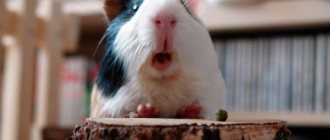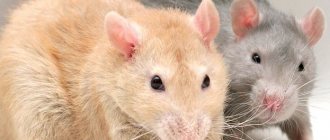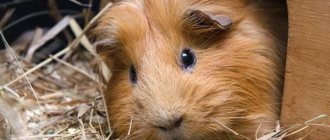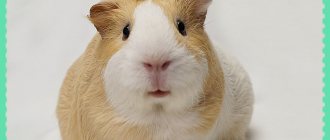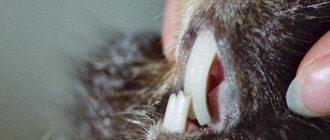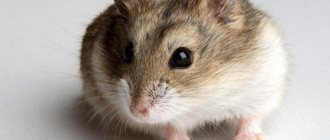№9
They have very poor eyesight. They suffer from myopia and, like many animals, see everything only in black and white. However, poor eyesight was replaced by an excellent sense of smell. Hamsters easily distinguish each other by smell and also easily recognize their owner by smell.
They are also sensitive to sounds. They can hear in the ultrasonic range.
In addition, they have sensory nerves at the ends of their antennae, which help them sense their surroundings and more easily navigate in the dark.
Hamster cheek pouches
This feature distinguishes hamsters from other rodents. The animal uses its cheeks to hide food and other things that interest it. The cheeks are a kind of bag for the rodent, with the help of which it carries things to its home. Greedy animals can even put a heavy nut on their cheek. The hamster will not spit out a shiny find, even if it finds something tasty.
A hamster can put a load in its cheeks, which will amount to a fifth of the weight of the rodent itself.
Cheek pouches are not only a reliable pocket for food, but also excellent airbags while swimming. Hamsters, taking air into their cheeks, float perfectly on the surface of the water.
№13
Unlike many other animals, they are not social. They prefer a lonely life. In the wild, between 7 and 10 weeks of age, the mother kicks her cubs out of the nest to begin independent life.
When several hamsters are placed together in one cage, conflicts and fights can occur, which often lead to the death of one of the hamsters. These animals are terribly territorial, so they will defend their territory even at the cost of their own lives.
We also recommend reading: Interesting facts about pandas
Hamster fur
A hamster is an animal with fluffy and soft fur. But it is better not to touch the fur of a shaggy African hamster. This animal is capable of destroying a predator that is stronger and larger than the rodent itself.
The hairs of the African hamster's fur are arranged in a very unusual way - on their surface there are small holes that vaguely resemble a carved lattice. Thanks to this, the hairs can absorb liquid and hold it inside. The hamster rubs its fur with the juice of poisonous plants, because of this the animal becomes dangerous to anyone who wants to bite it.
How do they understand the world around them?
As we have already seen, hamsters do not have the best vision, so they cannot rely on it alone. This led to the development of other senses that allowed him to complement what he saw.
Article on the topic: Is it possible to keep a dwarf and a Syrian hamster alone; will two hamsters get along together?
The hamster’s cage is full of various objects: a feeder, a drinking bowl, a wheel, a sleeping place and some others that the owners could provide for him to live comfortably. The animal effortlessly finds what it needs at any time of the day, and since it is not always possible to rely on vision, it resorts to the help of smell, hearing and touch, which are much better developed in hamsters than in humans.
In addition to the basic methods of touch, hamsters can use special organelles - vibrissae. This is what zoologists call the thick whiskers of rodents located not far from the nose. They grow from a special hair bag that has many nerve endings, so hamsters immediately react to objects touching their whiskers. This helps them explore the surrounding space and communicate with the owner (the animal will feel the one who is in constant contact with it).
A hamster's mustache also helps them understand the world.
Many animals mark their territory, hamsters are one of them, for this they need special scent glands that emit a specific smell. Tubules extend from the glands, through which this smell then spreads. Usually the animals mark the bedding and bars of the cage, but if the owners are not careful, the animal will also mark the furniture and carpets where it often roams.
They will not explore the same territory all the time; they will rather remember it and notice individual changes. By the way, if you dim the lights while walking your hamster, he will be much more comfortable.
How much does a hamster cost?
The price of a rodent depends on many factors:
- from the one who sells the animal (pet store, private person or nursery);
- availability of pedigree and documents;
- how rare a breed the animal is.
For example, a hamster from a private owner is much cheaper than in a nursery. But a private person will not give you a guarantee that the rodent is healthy and has good heredity.
When buying an animal at a pet store, you can be sure that the hamster has been checked by a veterinarian, but there is also no guarantee of a good pedigree.
Therefore, if you want to get a purebred hamster, then contact the nursery. For the rarest rodent you will pay no more than 1 thousand rubles.
Interesting fact No. 3 - the reserve does not last in the pocket.
They love to hoard their food. In fact, the name “hamster” comes from the German word hamstern , which means “to accumulate”, “to stock up”, “to bag”.
I bet a couple more will fit in?
While eating, these animals hide their food in special "pockets" called cheek pouches, which are located on either side of their faces, so they can snack later. These pouches can extend from the jaws to the shoulders.
It is best to feed your pet a special kibble formula for hamsters with a small amount of nuts and seeds, as well as fresh foods such as spinach, apples and carrots.
Hamster records: largest and smallest
There are more than 19 breeds of hamsters. Among them are dwarf English hamsters - PeeWee. Their length is about 2.5 centimeters including the tail.
A case was recorded when a hamster reached a length of 35 centimeters. This is an animal of the Radde breed. Hamsters of this breed are considered the largest, their weight can reach about one kilogram.
Interesting fact #1 - they were recently discovered!
It turns out that they were discovered not so long ago. Hamsters were first found in the Syrian desert less than 100 years ago. The most popular type (among small pets) is the Syrian.
Oh, come on!? We've lived there longer than you. It is still unknown who discovered whom first.
These fluffies, also called golden (golden) hamsters or teddy bears, grow up to 12-15 cm in length and live for two to three years.
Diseases and their prevention
Unfortunately, any type of hamster is extremely vulnerable to many colds and infectious diseases. Some of these diseases extremely weaken the animal's body, which can ultimately lead to its death. Including a certain part of the diseases will be caused by improper conditions of detention, and not by the breed characteristics of the species.
We list the most common ailments of hamsters.
Obesity. A common disease among all pets. The reasons are irregular and plentiful feeding together with a sedentary lifestyle. That is why keeping hamsters requires a lot of free space for games and entertainment. In their natural habitat, these animals spend about 90% of their active life in constant motion. Obesity can become a breeding ground for the development of many cardiovascular diseases.
Interesting facts about Syrian hamsters
Wild hamsters of this species are very warlike. They cannot stand strangers on their territory. These rodents are loners. If you decide to put a weaker animal in a cage with a Syrian hamster, you can be sure that the first one will bite the second one to death.
The Syrian hamster will not even carry its offspring near it - if the babies are not removed in time, they will be destroyed by the parent.
Zoologists have discovered an interesting fact about hamsters: these animals are omnivores. If you don't feed your pet meat and fish, he will become aggressive and bite. The female can even eat her newborn babies.
Fun Fact #5 – Close the Door!
They love to sleep in enclosed spaces. To do this, you can place items such as paper towel rolls and small flowerpots in the cage.
Yes, one-room apartment. But it's yours. All. And you’ll have to pay your mortgage in a week!
For bedding, use a clean, dust-free, absorbent material such as shredded paper or hay. Avoid using pine and cedar shavings; their fumes can cause breathing problems!
As a general rule, shavings, corn cobs, and walnut shells should not be used as bedding because they are dusty and indigestible when eaten.
Hamsters also love to dig, so provide them with plenty of nesting material (such as white paper towels or shredded paper).
Interesting things about babies
Let's look at some interesting information about these cute pets:
These rodents got their name from the Avestan language. Translated, it sounds like this: “the enemy who throws you to the ground.” This translation is justified by the fact that in order to collect seeds from the stems, the baby bends them down. This is the interesting origin of the familiar name. These rodents come in a variety of colors and sizes. For example, the body length of different individuals can vary from 5 to 34 cm. But it is easy to recognize a hamster, regardless of the species. They have well developed cheek pouches.
These rodents can live in the mountains at an altitude of up to 3.5 km; we are talking about individual species. Parents can eat their cubs, so the male is often separated from the offspring, and the female must be monitored. These rodents are nocturnal, so if you are not ready to fall asleep to the noise of an active animal running around in a cage, you should refuse to purchase such a funny and active pet. They are good swimmers; in order to float on the water like a float, they take air into their cheek pouches. They have no fear of heights, so unattended pets can fall from a height and get injured
Be vigilant and do not leave children unattended; carelessness can lead to the death of the child. They prefer to live alone. In the hole of this rodent there are many passages and passages in which they navigate. The most ordinary hamster can stock up on food weighing up to 90 kg. They store even more than they can eat during the winter. Cells extracted from Chinese hamster ovaries are used to produce medicines for a number of serious diseases. Some breeds of dwarf hamsters have the ability to delay the birth of new offspring if they have not yet finished feeding previously born offspring.
This is how nature took care of them. They do not have the ability to clearly see what is happening around them; they cannot distinguish colors. Despite poor eyesight, these animals have excellent hearing and sense of smell. The animals record their path with the help of odorous glands that are present in their bodies.
If we compare the age of a person with the age of this rodent, it would be about one year in the life of a hamster and twenty-five years in the life of a human. It is worth noting that these are very funny and smart pets. They can remember their name if the owner is patient. They can also be trained to carry out certain commands. In one night of hunting, this little one can run up to ten kilometers, just as domestic animals run a lot in a wheel. Babies are already born with teeth. Their teeth grow throughout their lives, so they need to be ground down on hard surfaces, this can be a special pebble or twigs. The weight of grains that they can carry in their cheek pouches can be 20% greater than the weight of their body. Just imagine how strong and resilient they are. The diet may contain not only grains and berries, but also small insects. Life expectancy ranges from two to three years, but this is not the limit; there are cases with long-lived pets.
Before you decide to have such an interesting and cute pet in your home, you need to familiarize yourself with its features so that you don’t regret your choice in the future. Despite the fact that this rodent is very small, being its owner is a big responsibility, do not forget this.
How to determine the sex of a hamster?
This information may be important if you keep several animals at once and do not plan to reproduce them. Finding out what gender an animal is is not very difficult. To do this, you need to examine him, but this should not be done abruptly so that he does not get stressed. Calm the animal down and treat it to something tasty. Gently take the animal in your arms and hold it on the fold of skin between the shoulder blades, but do not pull.
Inspect the back. Males have pronounced sexual characteristics, but females do not. You can presumably determine the sex simply by the size of the animal - males are usually much larger than females. The latter also have prominent nipples in the abdominal area. Determining the gender of a newborn animal is somewhat more difficult. This can be done along the gap between the anus and urinary opening. For girls this distance is usually less than for boys.
What can you feed hamsters besides dry food?
A mandatory addition to the diet is fresh grass and greens, especially in spring and summer. Useful vegetation:
- fresh dandelion leaves;
- carrot and beet tops;
- lettuce and celery;
- alfalfa and plantain;
- garden rose petals.
To feed your hamster greens at home, you need to be sure that they are completely safe. It’s better to grow this healthy supplement yourself: in your summer cottage or on a windowsill. Animals love fragrant parsley very much, but it should be given in small portions, since excess will have a laxative effect on the hamster’s stool. By analogy, exclude parsley from the diet of a pregnant or lactating female.
When feeding your pet celery, monitor the animal’s reactions, since the concentration of harmful substances in this plant may well be too high for a small organism. Park areas away from busy city roads are suitable for collecting fresh weed. The best option is grass collected outside the city, away from dusty highways. If it is not possible to collect fresh grass, you can germinate wheat or oats at home. Choose the juiciest greens for your pet, be sure to wash and lightly dry before feeding.
Place young shoots of fruit or berry crops in the cage so that the rodent has the opportunity to grind down its teeth. Twigs of apple and pear trees, raspberries, currants and rose hips, linden and acacia work well. First, you need to rinse it well under running water, pour boiling water over it and let it cool, after which you can safely offer it to the animal.
In winter, provide your hamster with plenty of hay with the addition of wheat ears. It is not forbidden to pour grain feed directly into the litter, as some breeders do. The rodent will be interested in obtaining grains, choosing the most delicious ones for itself. Sometimes you can treat your hamster to homemade popcorn, excluding additives in the form of sugar, salt and flavor enhancers.
If dry food contains a meager amount of vegetables and fruits, feed your pet with the following crops:
- pumpkin and zucchini;
- sour varieties of apples;
- sweet peppers and radishes;
- strawberries and wild strawberries;
- cherries and currants;
- cucumbers and tomatoes;
- bananas in any form.
It is better to give vegetables without peeling and in small portions. Do not feed hamsters dried fruits, especially those with excess sugar. As an exception, you can treat your pet to raisins or a dried apple slice.
Once or twice a week, rodents can be fed cottage cheese, boiled eggs, chicken breast, lean beef and rabbit meat, and boiled boneless fish. Eating animal products will not harm the rodent, since its wild counterparts can eat about 60% of such food. Twice a week you can give your pet grasshoppers or worms from a pet store, remembering to monitor portions in moderation.
HOUSEHOLD HOSTS
The burrow of the Djungarian hamster is not simple: several entrances lead vertically to a depth of 20 to 50 cm, where they are united by a common corridor that goes even deeper, sometimes with turns. The nesting chamber can be located at a meter depth! The animals spend most of the day in burrows, appearing on the surface for only two to three hours at night. Djungarian hamsters go out to feed already in complete darkness, but can linger after dawn. They feed on seeds, greens and insects, and the proportion of animal food can be very large. Having filled its cheek pouches with seeds, the hamster either takes the prey to the hole, or, if the shelter is far away, sets up temporary “storerooms”, sprinkling heaps of seeds with sand and leaving scent marks. Hamsters are nearsighted, so smells are of great importance to them, and they leave a lot of marks with urine, feces and even just bathing in sand.
Interesting facts about hamsters in the steppe
These hamsters are wild relatives of domestic animals. The common steppe hamster is a thunderstorm for fields, vegetable gardens and animals. Many have seen how these crumbs attacked a hare or a dog. The rodent won and immediately began to feast on the victim’s meat.
Hamsters fight not only with dogs, but also with their relatives. There can be many reasons for a battle: protection of reserves, desire to possess a female, defense of one’s territory, and so on.
There have been cases when the steppe hamster attacked a person. A wild hamster attacks simply to defend its territory.
Djungarian hamsters
Here are some interesting facts about Djungarian hamsters. They have a very unusual feature - from time to time hamsters fall into a stupor. This state lasts about 2 hours. Usually animals fall into a stupor if the ambient temperature is lower than normal. Stupor may also be caused by recent stress (for example, moving from a pet store to your home).
Interesting fact No. 6 - oh, teeth, my teeth...
Hamsters' teeth grow constantly. Therefore, you need to give them something to chew to keep their teeth healthy.
Like people, we wake up every morning and go brush our teeth (just kidding)
Wooden blocks and toys made from hay are good for this purpose, but avoid cedar, pine, and soft plastic items because they can be harmful if ingested.




